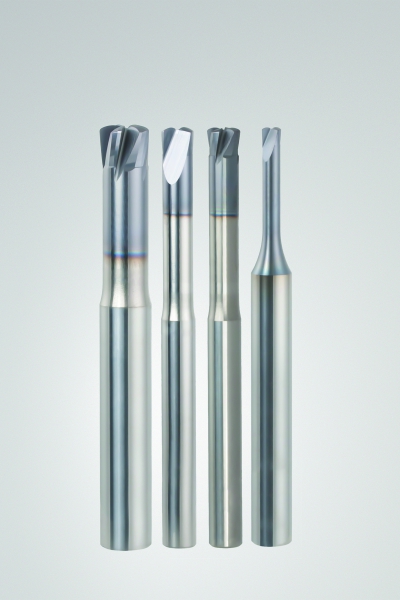
Niagara Cutter has expanded its range of endmills for high-feed milling applications. The new Niagara SN
200R/400R/500R solid-carbide endmills with 2-, 4- and 5-flute options allow parts manufacturers to achieve maximum productivity when performing face, slot and select plunge milling operations. Niagara applied the latest design and grinding developments to the SN 200R/400R/500R endmills, which feature a defined radius (rp) that helps direct radial cutting pressure axially up into the tool holder and spindle. This increases metal-removal rates in deep pocket and long-reach applications, and allows for more stable operation, less vibration and reduced wear on the machine tool, according to the company. As such, manufacturers can lower their production expenses and stay more competitive.
SN 200R/400R/500R endmills also feature an AlTiN coating that allows these endmills to achieve long, predictable tool life in milling applications involving high temperatures and abrasive workpiece materials, such as titanium and pH stainless steels. The coating also helps lower operating costs by eliminating the need for coolant in high-temperature situations.
Cutting diameters for the SN200R (2-flute) range are available from .063" – .500" in 3xD, 5xD and 7xD lengths. The SN400R (4 flutes) range spans .125" – .500" in 3xD, 5xD and 7xD lengths, while the SN500R (5 flutes) range covers .375" – .500" in 3xD lengths.
Optimal application of the SN 200R/400R/500R cutters is dependent on several factors, from the age of the machine tool being used to the part size being cut. For example, the cutters can run at maximum feed rates when applied alongside a highly rigid, modern machine tool. Proper programming is also important to ensure optimization of the cutter path. With the right CAM program, it is possible for the SN cutters to perform select plunge milling applications. Niagara can assist manufacturers in developing the most appropriate high-feed machining strategies for their operations.
Contact Details
Related Glossary Terms
- abrasive
abrasive
Substance used for grinding, honing, lapping, superfinishing and polishing. Examples include garnet, emery, corundum, silicon carbide, cubic boron nitride and diamond in various grit sizes.
- computer-aided manufacturing ( CAM)
computer-aided manufacturing ( CAM)
Use of computers to control machining and manufacturing processes.
- coolant
coolant
Fluid that reduces temperature buildup at the tool/workpiece interface during machining. Normally takes the form of a liquid such as soluble or chemical mixtures (semisynthetic, synthetic) but can be pressurized air or other gas. Because of water’s ability to absorb great quantities of heat, it is widely used as a coolant and vehicle for various cutting compounds, with the water-to-compound ratio varying with the machining task. See cutting fluid; semisynthetic cutting fluid; soluble-oil cutting fluid; synthetic cutting fluid.
- feed
feed
Rate of change of position of the tool as a whole, relative to the workpiece while cutting.
- gang cutting ( milling)
gang cutting ( milling)
Machining with several cutters mounted on a single arbor, generally for simultaneous cutting.
- grinding
grinding
Machining operation in which material is removed from the workpiece by a powered abrasive wheel, stone, belt, paste, sheet, compound, slurry, etc. Takes various forms: surface grinding (creates flat and/or squared surfaces); cylindrical grinding (for external cylindrical and tapered shapes, fillets, undercuts, etc.); centerless grinding; chamfering; thread and form grinding; tool and cutter grinding; offhand grinding; lapping and polishing (grinding with extremely fine grits to create ultrasmooth surfaces); honing; and disc grinding.
- milling
milling
Machining operation in which metal or other material is removed by applying power to a rotating cutter. In vertical milling, the cutting tool is mounted vertically on the spindle. In horizontal milling, the cutting tool is mounted horizontally, either directly on the spindle or on an arbor. Horizontal milling is further broken down into conventional milling, where the cutter rotates opposite the direction of feed, or “up” into the workpiece; and climb milling, where the cutter rotates in the direction of feed, or “down” into the workpiece. Milling operations include plane or surface milling, endmilling, facemilling, angle milling, form milling and profiling.
- plunge milling
plunge milling
Highly productive method of metal removal in which an axial machining operation is performed in a single tool sequence. The tool makes a series of overlapping, drill-like plunges to remove part of a cylindrical plug of material one after another. Because of the increased rigidity of a Z-axis move, the tool can cover a large cross-section of material.
- stainless steels
stainless steels
Stainless steels possess high strength, heat resistance, excellent workability and erosion resistance. Four general classes have been developed to cover a range of mechanical and physical properties for particular applications. The four classes are: the austenitic types of the chromium-nickel-manganese 200 series and the chromium-nickel 300 series; the martensitic types of the chromium, hardenable 400 series; the chromium, nonhardenable 400-series ferritic types; and the precipitation-hardening type of chromium-nickel alloys with additional elements that are hardenable by solution treating and aging.
- toolpath( cutter path)
toolpath( cutter path)
2-D or 3-D path generated by program code or a CAM system and followed by tool when machining a part.







